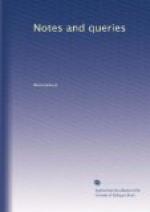“For legacyes, trentalls with scalacely
messys
Whereby ye have made the people very assys.”
(p. 17.)
And Simon of Swineshead, after drinking the poison, says,— {403}
“To send me to heaven god rynge the holye belle, And synge for my sowle a masse of Scala Celi, That I may clyme up aloft with Enoch and Heli.” (p. 82.)
There are bulls of indulgence in Scala Coeli in Rymer’s Faedera, xii. 565. 591. 672., xiii. 102.; but I can now only give the reference, as I have not that work in hand.
C.H. COOPER.
Cambridge, April 6, 1850
* * * * *
WATCHING THE SEPULCHRE.
“T.W.” (No. 20. p. 218.) will find no end of “Items” for watching the sepulchre, in the “Churchwardens’ Accounts” before the Reformation, and during the reign of Queen Mary. At Easter it was the custom to erect a sepulchre on the north side of the chancel, to represent that of our Saviour. This was generally a temporary structure of wood; though in some churches there still remain elaborately ornamented ones of stone. Sometimes the founder’s tomb was used for the purpose. In this sepulchre was placed on Good Friday the crucifix, and occasionally the host, with other emblems; and a person was employed to watch it till the morning of Easter Day, when it was taken out with great ceremony, in imitation of our Lord’s resurrection. It was the payment for this watching that occurs continually in the Churchwardens’ Accounts, and of which, it appears, Fuller could not understand the meaning. A paper on the subject of Easter sepulchres, by Mr. Venables, was read at the meeting of the Cambridge Camden Society in March, 1843, but I am not aware whether it has been printed. Some very curious “Items” on this subject are given in Britton’s Redcliffe Church, which are quoted in the Oxford Glossary of Architecture. They are so illustrative, that I subjoin them, to give you an opportunity, if you please, of serving them up to your readers:—
“Item, That Maister Canynge hath deliver’d, this 4th day of July, in the year of Our Lord 1470, to Maister Nicholas Petters, Vicar of St. Mary Redcliffe, Moses Conterin, Philip Barthelmew, Procurators of St. Mary Redcliffe aforesaid, a new sepulchre, well gilt with gold, and a civer thereto.
“Item, An image of God
Almighty rising out of the same
sepulchre, with all the ordinance
that ’longeth thereto; that is
to say, a lathe made of timber
and the iron work thereto.
“Item, Thereto ’longeth
Heaven, made of timber and stained
clothes.
“Item, Hell, made of
timber, and the iron-work thereto, with
Divels to the number of 13.
“Item, 4 knights, armed,
keeping the sepulchre, with their
weapons in their hands; that
is to say, 2 axes and 2 spears,
with 2 paves.




